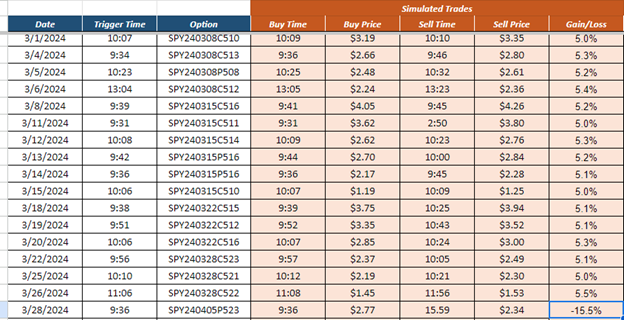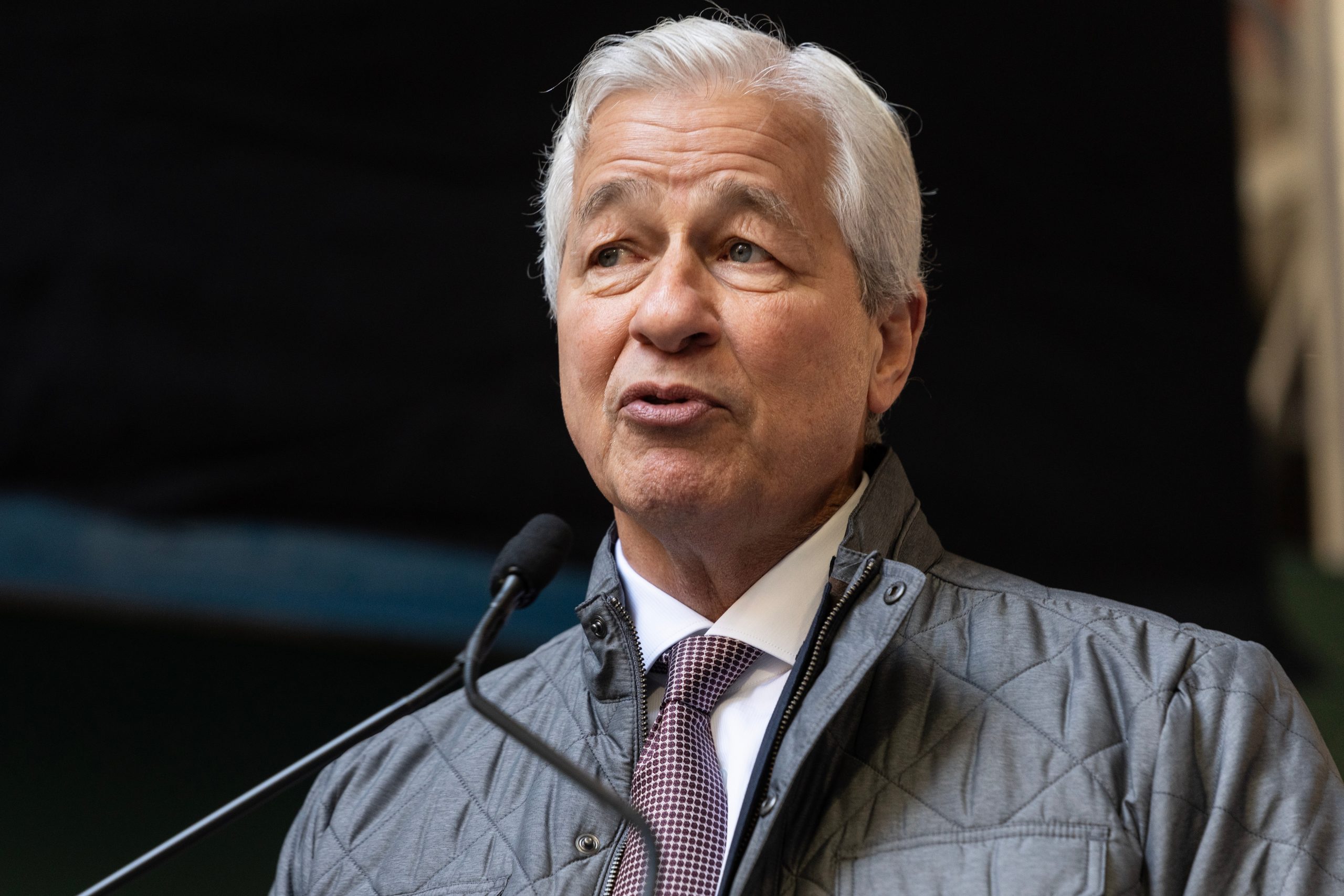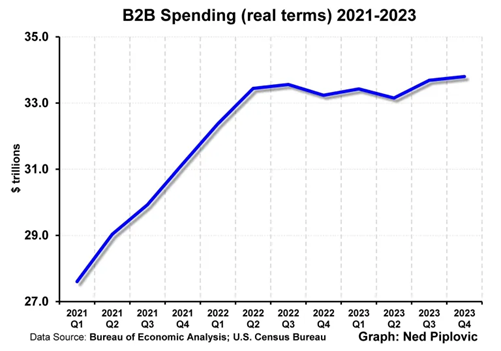Six Reasons to Day-Trade for Income with a Signal
By: Paul Dykewicz,

Six reasons to day-trade for income with a signal can put people on a profitable path if they are prepped for the pursuit.
The DayTradeSpy Signal is an investment advisory service that uses indicators to provide its subscribers with roughly three to five trade recommendations per week. DayTradeSpy Signal racked up 16 profitable trades among its 17 tries in March 2024 to attain a 94.12% success rate, then turned a profit in its first five recommendations in April to enhance its performance to 21 winners in 22 attempts for an even better 95.45% win rate during the expanded time span.
“We’re going to have to do something about that one trade that got away,” said Hugh Grossman, a seasoned options trader and trainer who founded DayTradeSpy Signal, the Ultimate Training Workshop, the DayTradeSpy Trading Room and the Pick of the Day advisory services.
Six Reasons to Day-Trade for Income with a Signal: 1. Quick Cash
Investors seeking to amass cash quickly have a chance to do so by day-trading options, Grossman said. Some investors may be content to pay dividend-paying stocks and wait for the payouts, but Grossman said he prefers to try to earn income each day he trades options.
In the DayTradeSpy Signal service, Grossman bases his recommendations on the SPDR S&P 500 ETF Trust (SPY), a highly liquid and diversified exchange-traded fund (ETF) that follows the top 500 stocks in America. The fund is familiar to many investors due to its sheer volume, and is resistant to market manipulation, Grossman said. DayTradeSpy Signal recommends options in the SPDR S&P 500 ETF Trust (SPY), the largest and first U.S.-listed exchange-traded fund (ETF).

“The trader will purchase immediately upon receiving the signal through a cell phone text or email,” Grossman explained. “The alert will provide a specific option to buy, including its expiration date. Then, right after the purchase, put it up for sale with a 5% target price. If, on rare occasions, it does not fill by the end of the day, the trader needs to simply sell it for the market price at close. It’s an easy system that has proven to be highly effective and reliable.”
Naysayers may point out that a 5% gain is not a “home run,” Grossman said. But it is “relatively easy” to obtain such a small gain without needing to watch a computer screen all day, he added.
“This program is ideal for those who may still be working during market hours or out enjoying a sunny day on the boat,” Grossman said. “Simply check back on your cell phone at 4 p.m. and, if the sell order did not trigger, then proceed to sell it. These sell orders can usually be automated as well.”
Six Reasons to Day-Trade for Income with a Signal: 2. High Success Rate
Since the DayTradeSpy Signal service began in November 2023, the option trading advisory service has turned profits in 59 of its 69 trade recommendations, or an 85.5% win rate as of April 8.
“The way it works is simple enough,” Grossman said. “As a subscriber, you would receive an alert via cell phone text and email. As soon as you are notified, immediately make your purchase. Buy the suggested option, using a limit order for the ask price, within the next two minutes.
“As soon as you buy it, immediately put it up for sale for a 5% gain. In the unlikely event that it did not sell by the end of the day, sell it for the market price at the close. Should that happen, you would never drop to zero as these trades do have time built into them.”
In the case of the only losing trade in March 2024, the option did not reach the 5% profit goal by the end of the day. To adhere to the DayTradeSpy Signal strategy of closing each trade before day’s end, the order to sell the position at the market price led to a loss of about 15%.
Five Reasons to Day-Trade with a Signal: 3. ‘Excellent Strategy’
Statistically, DayTradeSpy Signal has proven to be an “excellent strategy,” Grossman said. The advisory service provides three to five algorithm-driven trades per week, he added.
“We suggest taking a mere 5% gain,” Grossman said. “But here’s the kicker: those actually watching the markets tend to do much better. They track the price up, making much higher gains. Check out the table below for April’s results.”

Source: Hugh Grossman
The target is at least a 5% profit on each trade, Grossman told me.
“Some traders make much more than that,” Grossman said.
DayTradeSpy Signal emails alerts to subscribers’ inboxes and texts them to their cell phones. Income investors can receive same-day payouts with successful trades, Grossman continued.
“In addition, there is some inherent excitement in placing these trades, beating the S&P 500 in its own game,” Grossman said. “When I receive the Signal, I’m pumped.”
Five Reasons to Day-Trade with a Signal: 4. Expert Analysis
This is an “ideal strategy” for those unable or unwilling to do the analysis themselves, Grossman continued.
“Many of our busy subscribers like this program, as it provides the work for them; they just have to follow through,” Grossman said. “You get three to five alerts a week, generally in the morning.”
All the March 2024 trades are detailed in the table below. Even though DayTradeSpy Signal has an 85%-plus success rate thus far, Grossman mentioned that options trading is risky and does require a certain amount of analysis.
Profitable Trades Notched in 16 of 17 Signal Recommendations in March 2024

Source: Hugh Grossman
Five Reasons to Day-Trade with a Signal: 5. Proven Formula
DayTradeSpy Signal advises its subscribers whether to pursue each trade, the market direction and strength, which option to trade and how to trade it. The DayTradeSpy Signal does the “heavy lifting” for its subscribers, Grossman said. Simply buy the recommended option, put it up for sale and come back later to reap their rewards or cut bait, he added.
As for the loss, SPY moved to the upside at about 2:45 p.m. that day, only to collapse just minutes before the close of trading, Grossman said. The market did not bid up SPY enough that day to allow traders to take the desired 5% profit on the puts, he added.
“Some days, you’re the dog,” Grossman told me. “Other days, you’re the hydrant.”

Hugh Grossman leads DayTradeSpy Signal, Trading Room and Ultimate Training Workshop.
Five Reasons to Day-Trade with a Signal: 6. Protection from Crises
Short-term trades of just minutes or hours in a single day limit the fallout from crises like wars and natural disasters. Long-term investors face those perils, but day-traders are insulated from the worst effects of those calamities.
JPMorgan Chase Chairman and Chief Executive Officer Jamie Dimon warned that “significant challenges” across the globe in 2023 are carrying over into 2024 and could worsen. In a JPMorgan shareholders’ letter, Dimon wrote that the terrible ongoing war and violence in the Middle East and Ukraine, mounting terrorist activity and growing geopolitical tensions, especially with China, pose threats to investors and others.
“Almost all nations felt the effects last year of global economic uncertainty, including higher energy and food prices, inflation rates and volatile markets,” Dimon wrote. “While all these events and associated instability have serious ramifications on our company, colleagues, clients and countries where we do business, their consequences on the world at large — with the extreme suffering of the Ukrainian people, escalating tragedy in the Middle East and the potential restructuring of the global order — are far more important.”

Jamie Dimon, chairman and CEO of JP Morgan Chase.
America’s Global Leadership Role Under Threat, JP Morgan Chase CEO Cautions
“America’s global leadership role is being challenged outside by other nations and inside by our polarized electorate,” Dimon wrote in his letter to JPMorgan Chase’s shareholders. “We need to find ways to put aside our differences and work in partnership with other Western nations in the name of democracy. During this time of great crises, uniting to protect our essential freedoms, including free enterprise, is paramount.”
America, “conceived in liberty and dedicated to the proposition that all men are created equal,” serves as a shining beacon of hope to citizens around the world, Dimon wrote. JPMorgan Chase, a company that historically has worked across borders and boundaries, will do its part to ensure that the global economy is safe and secure, he continued.
Despite an “unsettling landscape,” including last year’s regional bank turmoil, the U.S. economy continues to be resilient, with consumers still spending, and the markets expecting a soft landing, Dimon wrote. However, the economy is fueled by large amounts of government deficit spending and past stimulus, he added.
“There is also a growing need for increased spending as we continue transitioning to a greener economy, restructuring global supply chains, boosting military expenditure and battling rising health care costs,” Dimon wrote. “This may lead to stickier inflation and higher rates than markets expect. Furthermore, there are downside risks to watch. Quantitative tightening is draining more than $900 billion in liquidity from the system annually — and we have never truly experienced the full effect of quantitative tightening on this scale.”
The “ongoing wars” in Ukraine and the Middle East have the potential to disrupt energy and food markets, migration, military and economic relationships, in addition to their dreadful human cost, Dimon wrote. These significant and somewhat unprecedented forces warrant caution, he added.
Solar Eclipse Could Be a Prelude to Covering up Economy Resiliency
The eclipse of the sun that occurred above much of the United States on Monday, April 8, may be symbolic of a gradual covering up of President Biden resilient economy later this year, wrote Mark Skousen, PhD, who heads the Forecasts & Strategies investment newsletter.
The U.S. Bureau of Economic Analysis (BEA) recently released its third estimate of real gross domestic product (GDP) growth at a 3.4% annual rate for the final quarter of 2023, as well as 2.5% for the full year. But BEA also reported gross output (GO), which is a much broader measure of total economic activity, including the all-important supply chain, which showed an economic slowdown, said Skousen, who also is a Presidential Fellow in economics at Chapman University.

Mark Skousen, head of Forecasts & Strategies, meets with Paul Dykewicz.
“Real GO was a full percentage point below gross domestic product in the fourth quarter, 2.4%,” Skousen reported.
“Worse, business-to-business spending actually fell slightly, by 0.3%… and has been virtually flat since the start of 2022, as this chart shows,” Skousen wrote.

“GO and business spending are leading indicators, suggesting a slowdown and perhaps even a recession in 2024,” Skousen cautioned. Click here to read Skousen’s op-ed about GO and the risk of a recession in the March 5 edition of the Wall Street Journal.
China’s Aid to Russia Adds to Mounting Geopolitical Risk Amid Increasing Danger in Middle East
Media reports indicate China has been providing machine tools, drone and turbojet engines, as well as technology for cruise missiles, microelectronics and other capabilities to help Russia make propellant for weapons to use against the Ukraine. China also has been helping Russia build drones to wage war.
China’s support is aiding Russia in sustaining its invasion of Ukraine that began in February 2022. Meanwhile, Ukraine’s forces are incurring severe shortages of weapons as the U.S. Congress has been unable to agree on a new foreign aid package.
With that backdrop, Russia’s military forces are advancing in eastern Ukraine after capturing the key town of Avdiivka in February. Ukraine’s soldiers are trying to hold their ground but struggling to do so amid long-term shortages of artillery shells.
In the Middle East, the risk of escalation is rising. Israel’s efforts to find and destroy an extensive tunnel system in neighboring Gaza that has been used to store weapons, as well as hide Hamas leaders and militants who were responsible for the Oct. 7 attack that killed an estimated 1,200 people, as well as taking 240 hostages, have led to a huge loss of life. The Gaza Ministry of Health estimates that more than 33,634 Hamas fighters and civilians have lost their lives there since the war began Oct. 7, but this month’s death toll also includes seven World Central Kitchen aid providers who perished when the vehicles that they were using to distribute food were fired upon by Israel Defense Forces (IDFs) who reportedly mistook them for hostile militants.
Chef José Andrés, World Central Kitchen’s leader, called for an independent investigation and said the vehicles were clearly marked with a sign of his charity, which reported its planned movements to the IDF in advance. The IDF announced that two senior officers were dismissed as a result of its probe of the incident.
U.S. President Joe Biden spoke by phone with Israel’s Prime Minister Benjamin Netanyahu to warn that future U.S. assistance to Israel will depend on how humanitarian interests are addressed in Gaza moving forward. Biden added that he was “heartbroken” by the deaths of the World Central Kitchen aid workers.
The number of injured people from the war in Gaza is estimated by its Ministry of Health to top 75,600 people. Israeli military officials reported that at least 256 of its soldiers have been killed since they entered Gaza to try to free an estimated 100 hostages who remain alive. Hamas or other Palestinian militants reportedly hold the remains of 30 hostages who were killed during and after the Oct. 7 raid of Israeli communities near its border with Gaza.
The use of SPY options in the DayTradeSpy Signal advisory service offers income investors an alternative to traditional stock investing, especially if a recession arises and geopolitical risk escalates.
Paul Dykewicz, www.pauldykewicz.com, is an accomplished, award-winning journalist who has written for Dow Jones, the Wall Street Journal, Investor’s Business Daily, USA Today, the Journal of Commerce, Seeking Alpha, Guru Focus and other publications and websites. Paul, who can be followed on Twitter @PaulDykewicz, is the editor of StockInvestor.com and DividendInvestor.com, a writer for both websites and a columnist. He further is editorial director of Eagle Financial Publications in Washington, D.C., where he edits monthly investment newsletters, time-sensitive trading alerts, free e-letters and other investment reports. Paul previously served as business editor of Baltimore’s Daily Record newspaper. Special Sale! Paul is the author of an inspirational book, “Holy Smokes! Golden Guidance from Notre Dame’s Championship Chaplain,” with a foreword by former national championship-winning football coach Lou Holtz. The uplifting book is great gift and is endorsed by Joe Montana, Joe Theismann, Ara Parseghian, “Rocket” Ismail, Reggie Brooks, Dick Vitale and many others. Call 202-677-4457 for reduced pricing on multiple-book purchases.











